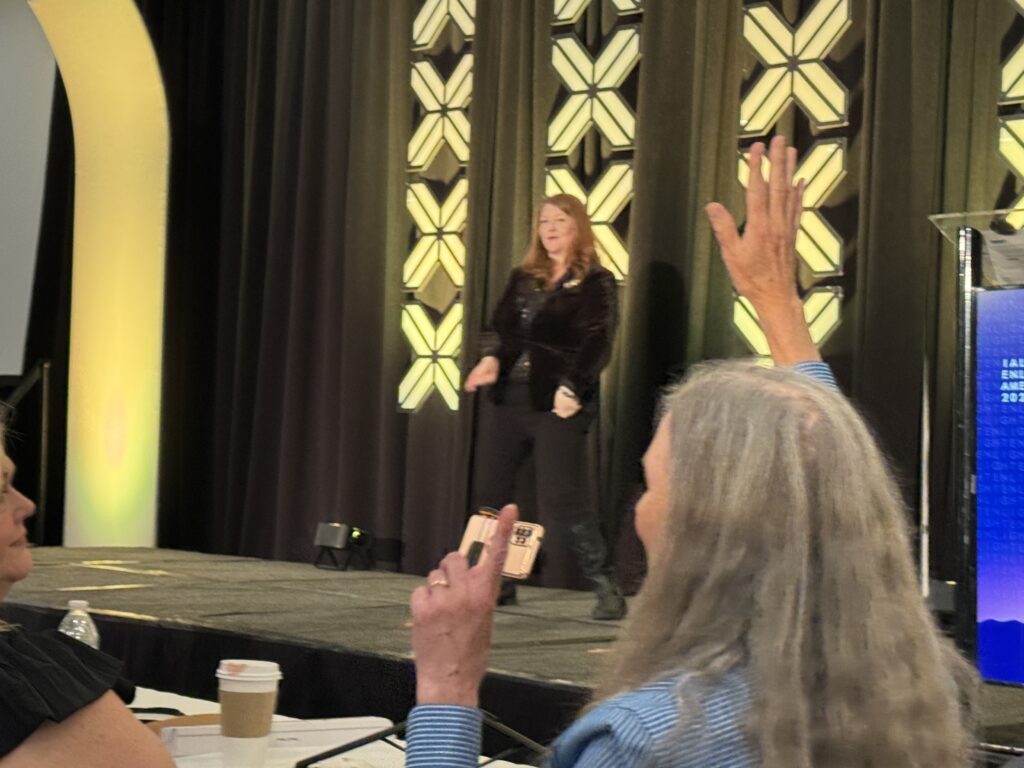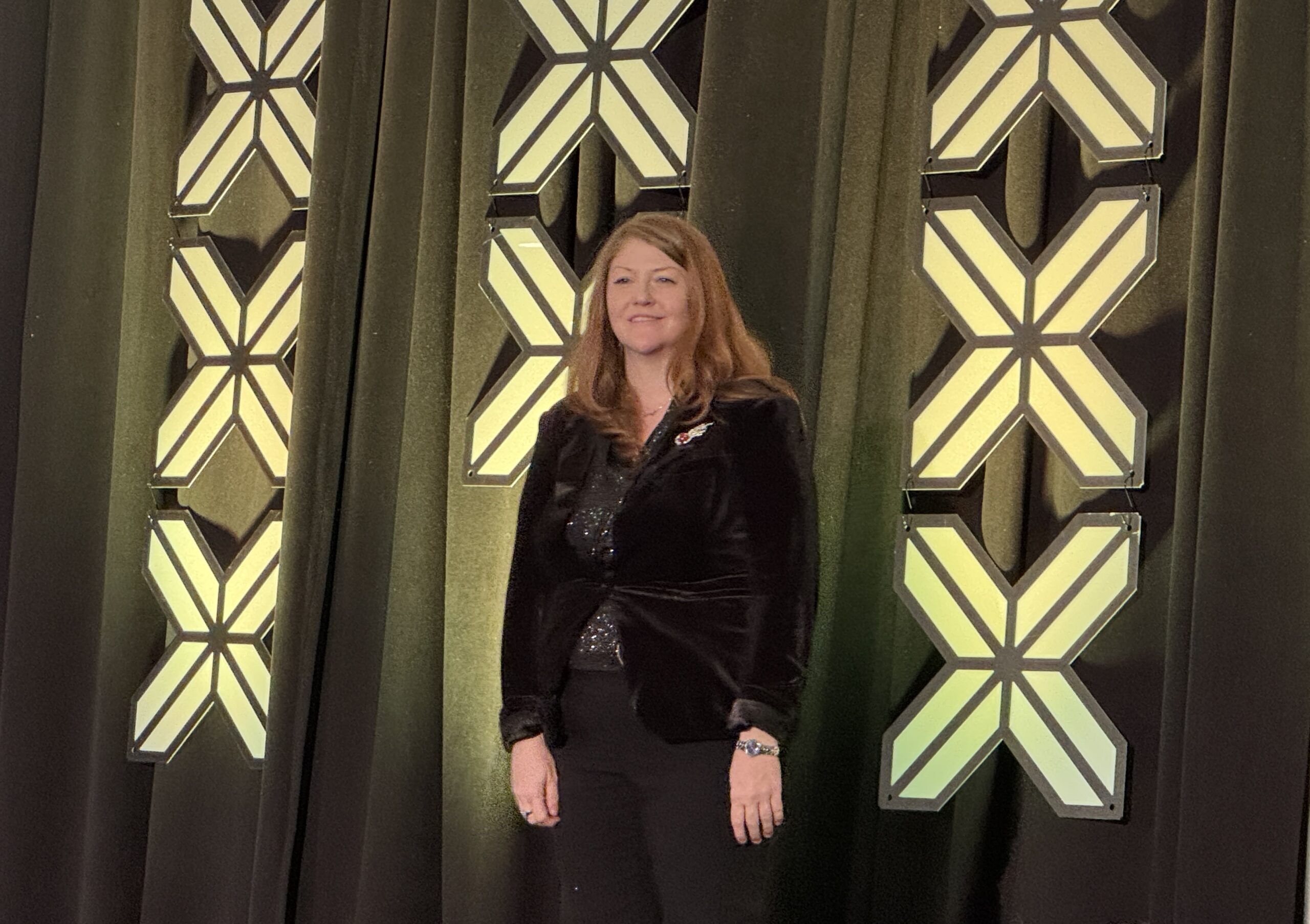Amy Oliver’s IALD 2025 Keynote: Dark Skies and Collaboration that Shines
The International Association of Lighting Designers (IALD) opened its 2025 conference with a keynote by Amy C. Oliver, FRAS, light-pollution scientist and science center director for the Smithsonian Astrophysical Observatory’s Fred Lawrence Whipple Observatory. Titled “Beyond the Glow: Tackling Light Pollution for Research, Ecosystems, and Economies,” Amy’s IALD 2025 keynote was a heartfelt call to action, urging lighting designers to blend human creativity with nature’s beauty. Delivered with wit and a nerdy love for the cosmos, her talk inspired the room. But the real spark came in the Q&A, where a pivotal exchange between Carrie Hawley, Senior Principal and CEO of HLB Lighting Design, and Nancy Clanton, Founder and Principal of Clanton & Associates, Inc., showed why IALD’s collaborative spirit drives our industry forward.
Amy’s Desert Night Sky Story
Amy, known as the Nerdy Astronomer, painted the Sonoran Desert as a vibrant backdrop—home to jaguars, blooming cacti, and dark skies fueling science and tourism. As principal investigator of Dark SkyNet and Project GLOWworm, she wove personal tales—like a light bulb warming her chinchilla, Sonny—with data on skyglow, the artificial light scatter that hides stars and harms ecosystems.
“Tucson is a living laboratory,” Amy said, highlighting its UNESCO gastronomy status and Outdoor Lighting Code Committee, where scientists, developers, and designers craft light pollution solutions. She showed a 1959 photo of Tucson’s pristine night sky, contrasting it with 2025’s skyglow dome, proving even a leader in light pollution control faces challenges. “It’s not one light,” she stressed. “It’s the congregation of light.” Blue light—under 500 nanometers or above 4,000 Kelvin—scatters widely, creating glows visible 180 miles away, from Death Valley to California’s coast.
Amy’s examples resonated. Fireflies pushed to higher elevations, cacti starved by 8,000K LEDs, bees unable to rest in lit flowers—these losses are preventable. She urged dark sky design with 2,700K fixtures and downward shielding to preserve the Milky Way over Tucson’s homes. Dark skies also drive economics: Arizona’s observatories, like Whipple, generate Super Bowl-level revenue yearly, and global dark sky tourism yields billions. “It’s a choice,” Amy said. “You, lighting designers, make it possible.”

Nancy Clanton Directly Responds to Carrie Hawley’s Comment at the IALD Enlighten Americas 2025
The Q&A That Stole the Show
The Q&A ignited when Carrie spoke up. With frustration and resolve, she tackled “ridiculous requirements,” like the outdated 10-footcandle (fc) standard for outdoor pool area steps. “Our hands are tied,” she said, calling for collaboration to push back. Her question was a plea for the teamwork IALD fosters.
Amy, moderating, shared brief thoughts but was signaled by IALD to wrap up. Nancy wasn’t deterred. Hand raised, she declared she and a few others in the room have addressed that with the International Building Code (IBC), that exact 10 fc standard, and secured its revision to a practical 1 fc. Nancy explained the IBC will be one foot candle average by the railing to address glare. The room erupted in applause, celebrating shared expertise.
Post-session, I caught up with Nancy and Charles Stone, Founder and Principal of Fisher Marantz Stone. Nancy explained the IBC update will let designers cite the 1 fc standard, blending aesthetics and sustainability. She emphasized to Charles and me that this change was in final review. Their talk showed why IALD’s collaborative vibe matters—uniting designers, scientists, and policymakers to redefine what’s possible.
IALD’s Collaborative Magic
Amy’s keynote and the Carrie-Nancy exchange proved IALD 2025 is a crucible for change. Carrie’s challenge was about breaking free from creative constraints. Nancy’s response showed one designer’s persistence can shift global standards. This is IALD’s magic: passionate friends—designers, architects, scientists—swapping ideas and sparking action.
Amy echoed Randy Burkett’s cosmic view, referencing the Pale Blue Dot: “That speck is our home. Light keeps us alive.” How we use light defines us. From Tucson’s starlit deserts to urban rooftops, IALD’s collaboration ensures responsible lighting—preserving ecosystems, boosting economies, and keeping stars in view. As Amy said, “Keep looking up, down, and all around.” At IALD, we do just that.




